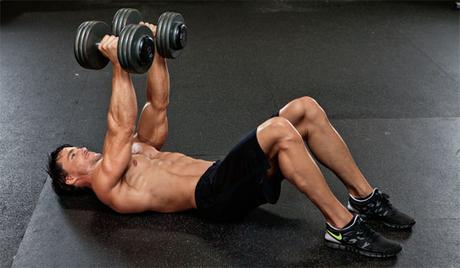Building a huge chest is one of the biggest goals for many weight lifters and aspiring bodybuilders. Unfortunately, the best, most basic pectoral exercises, such as barbell bench presses, incline presses, and decline presses do not work for some trainees. Some lifters find that these exercises don't do a good enough job of specifically working their chests, while others have problems with their shoulders and rotator cuffs that prevent them from using a barbell for pressing movements. If you are one of these trainees, you don't need to worry; here are 3 unconventional pectoral exercises that can effectively work your chest while keeping your joints safe.

Chest Dips
Though people most often use dips as a triceps-building exercise, I have found them to be one of the best pectoral exercises out there. Many dip stations have angled bars that allow you to grip narrow, wide, or anywhere in between. If you are looking to work mainly chest with this movement, take a moderately wide grip that doesn't hurt your shoulders. You should also try to dip down to a point at least a little bit lower than where your upper arms are parallel to the floor. You will have to experiment to find the best range of motion for yourself.
You can perform dips with just your bodyweight, but you should focus on gradually adding external resistance. Most gyms have dip / pull-up belts that you can use at no extra cost. Aim to increase your strength on a heavy set to failure of 4-8 reps each time you do this movement. You can also follow this heavy set with one of bodyweight reps to failure.
Dumbbell Floor Press
You may have heard the merits of using different types of dumbbell presses as your mainstay pectoral exercises. While they certainly can work wonders for people struggling with chest development from barbell movements, they do not allow you to use nearly as much weight. One way to solve this problem is to do floor presses with dumbbells instead of the normal flat press. Unless your arms are very short, pressing from the floor will shorten the range of motion of the press by several inches, while still providing great stimulation for your chest.
The difficult thing about this exercise is getting the dumbbells into position. The best way is to stand them upright on the floor next to where your thighs will be. Sit on the floor, and hoist the one on your non-dominant side up onto your thigh. Either get a spotter to hand you the other dumbbell, or find the best way for your body type to get it up onto your thigh. Once both dumbbells are resting on your legs, simply lay back and press. You may need to situate your upper back properly once you get the first rep up. Work your way up to two top sets of 8-10 reps.
Suspended Push-Ups
There are many devices you can use for this movement, but the basic idea is to do push-ups from an unstable set of handles. Many people use two loops of chains suspended a few inches from the ground. There are also special handles made for this exercise that you can hang from a power rack or smith machine. Suspended Push-Ups are not only one of the best "hidden" pectoral exercises, but they will improve your coordination and stability by challenging you to remain in the correct path while pressing from an unstable "surface."
You can have someone add external resistance by placing weights on your back, but I have always preferred to do this movement with just my bodyweight at the end of a training session. If you do the same, perform 2-3 sets of as many reps as you can get. When this becomes too easy, start having a spotter add a 25 or 45 pound plate to your back.
Source

